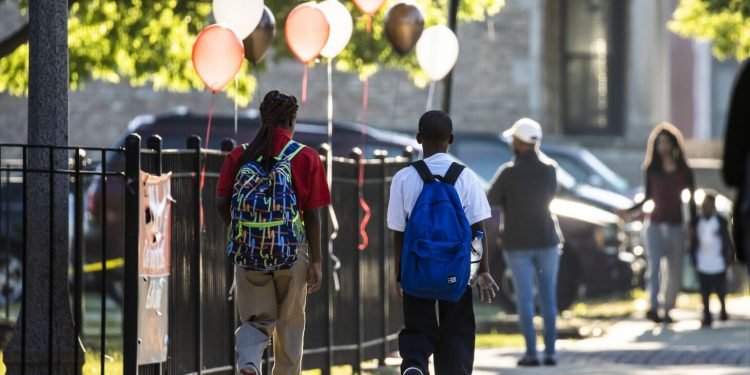This previous week marked the primary day of faculty in our neighborhood. I’m a sucker for the household tableau — a child along with her new backpack, mother and pop with cameras on the prepared because the bus pulls up.
It’s alarming to contemplate how probably it’s that by the point that smiling little one reaches highschool, she will probably be anxious, depressed or reducing herself. In accordance with the surgeon basic, 19% of highschool college students severely think about suicide. Neither is it simply musing. Between 2007 and 2018, suicide charges amongst younger individuals between 10 and 24 elevated by 57%.
As Jonathan Haidt and Greg Lukianoff have explored, the extensive adoption of smartphones in 2012 marked a sudden and dramatic change in adolescent well-being. Youngsters, particularly women, turned extra anxious, depressed and fragile.
Youngsters and youngsters have been spending hours every day on their telephones earlier than COVID, with results that apprehensive a variety of observers. Jean Twenge of San Francisco State College analyzed findings from nationwide surveys of excessive schoolers relationship again to 1976 and located that children should not socializing face-to-face as a lot as they used to. They attend fewer events, spend much less time hanging out in individual with their mates and even date lower than did children in earlier many years.
To make sure, youngsters being on their very own had some plain advantages. Charges of adlescent being pregnant dropped up to now twenty years, as did drug experimentation and alcohol abuse. However charges of unhappiness rose sharply.
The addition of COVID to this already ailing social system was a heavy blow. A 2020 survey sponsored by Chicago Youngsters’s Hospital discovered that 71% of oldsters believed the pandemic had taken a toll on their kids’s psychological well being. A nationwide survey of highschool college students discovered that just about a 3rd felt sad or depressed way more than regular.
The info on emergency room admissions for psychological well being crises counsel that one thing actually is altering. ER visits elevated 24% in 2020 in contrast with 2019 for youths between 5 and 11, and 31% for these aged 12 to 17. The development of youngsters in disaster is extreme sufficient that the American Academy of Pediatrics, the American Academy of Little one and Adolescent Psychiatry and the Youngsters’s Hospital Affiliation issued a joint declaration of a “Nationwide Emergency in Little one and Adolescent Psychological Well being” in October 2021. Psychological well being professionals additionally observe that sources like psychiatric beds and little one psychiatrists and psychologists are fairly restricted, forcing an estimated 80% of youngsters with severe sickness to forgo remedy.
COVID was a respiratory pandemic, nevertheless it revealed an underlying sickness that’s maybe much more dangerous — a loneliness epidemic. The well being insurer Cigna printed a research discovering that 3 in 5 Individuals report being lonely and feeling disregarded, poorly understood, and missing companionship.
We needs to be pausing at this post-COVID second to mirror on some classes about the way in which we dwell now. Certainly one of them is that we’re spending too rattling a lot time alone. Individuals want face-to-face contact.
We shouldn’t want social science to inform us that people want companionship, however generally our conveniences swamp our higher judgment. I can’t think about residing with out a smartphone and would by no means counsel a Luddite response to know-how. However we do want to higher accommodate our social wants.
We’ve been residing in teams for about 300,000 years, and but we nonetheless don’t totally perceive the complicated position that facial expressions, physique language and even smells play in our well-being. Earlier than adopting practices that violate our groupish natures, we should assume twice.
For adolescents, loneliness just isn’t relieved by social media; actually, social media makes it worse. A Wall Road Journal report on Fb’s inner memos revealed that “32% of adlescent women stated that after they felt dangerous about their our bodies, Instagram made them really feel worse,” and “(a)mong teenagers who reported suicidal ideas, 13% of British customers and 6% of American customers traced the will to kill themselves to Instagram.”
Students and researchers have proposed reforms to the way in which we increase children and the way in which we use social media. Jean Twenge, Clare Morell and Brad Wilcox have beneficial a collection of steps state legislatures ought to think about to restrict the hurt of social media to kids and youths. One is to mandate age verification for porn websites and social media. One other is to require that social media platforms be shut down for all children in a single day. Sleep deprivation from social media overuse is an actual drawback, which might itself contribute to melancholy.
These are good begins, however we should be extra conscious of our social selves and our want for each other. We have to reorganize our lives, and particularly our youngsters’ lives, to make certain they’re residing IRL and never simply on-line. We would like that smiling grade schooler to turn out to be a radiant teen.
MonaCharenis coverage editor of The Bulwark and host of the “Beg to Differ” podcast.
The Solar-Instances welcomes letters to the editor and op-eds. See our guidelines.











